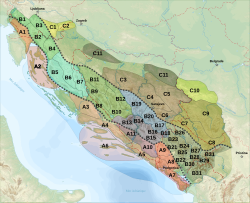| Dinara | |
|---|---|
 Dinara from Cetina. | |
| Highest point | |
| Elevation | 1,913 m (6,276 ft) |
| Prominence | 1,086 m (3,563 ft) |
| Listing | Country high point |
| Coordinates | 43°56′42″N16°35′49″E / 43.9450943°N 16.59693°E |
| Geography | |
 | |
| Location | Bosnia and Herzegovina / Croatia |
| Parent range | Dinaric Alps |
Dinara is a 100-kilometre-long (60-mile) mountain range in the Dinaric Alps, located on the border of Bosnia and Herzegovina and Croatia. It has four major mountains or peaks, from north-west to south-east: [1]
Contents
- Etymology
- Dinara Mountain
- Climate
- Tourism
- Flora and fauna
- Flora
- Fauna
- Gallery
- See also
- Citations
- General sources
- Bibliography
- Alpinism
- Biology
- External links
- Ilica or Ujilica (1,654 m)
- Sinjal or Dinara (1,831 m), eponym to the range, highest mountain in Croatia
- Troglav (1,913 m), highest peak in the range
- Kamešnica, with peak Konj (1,855 m) [2]
Note the dual use of the name Dinara, which is also the origin of the name for the whole Dinaric Alps. [3] The range is composed of limestone and dolomite. [4]




